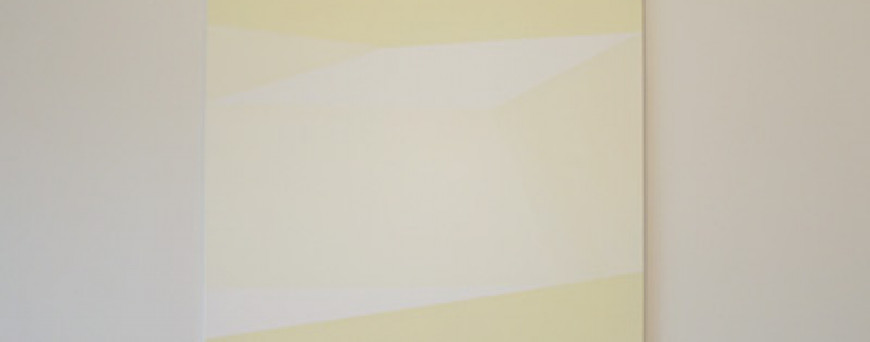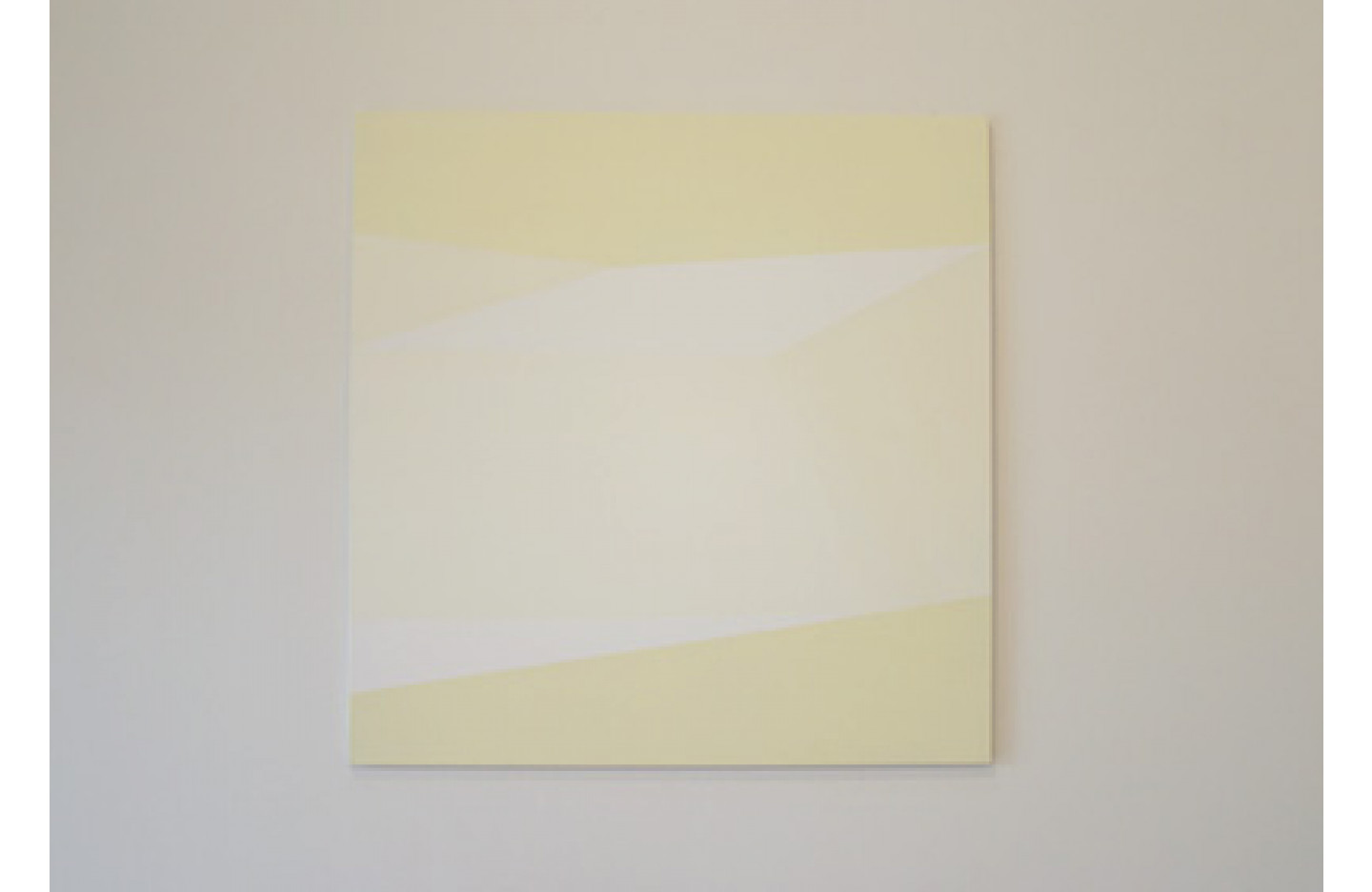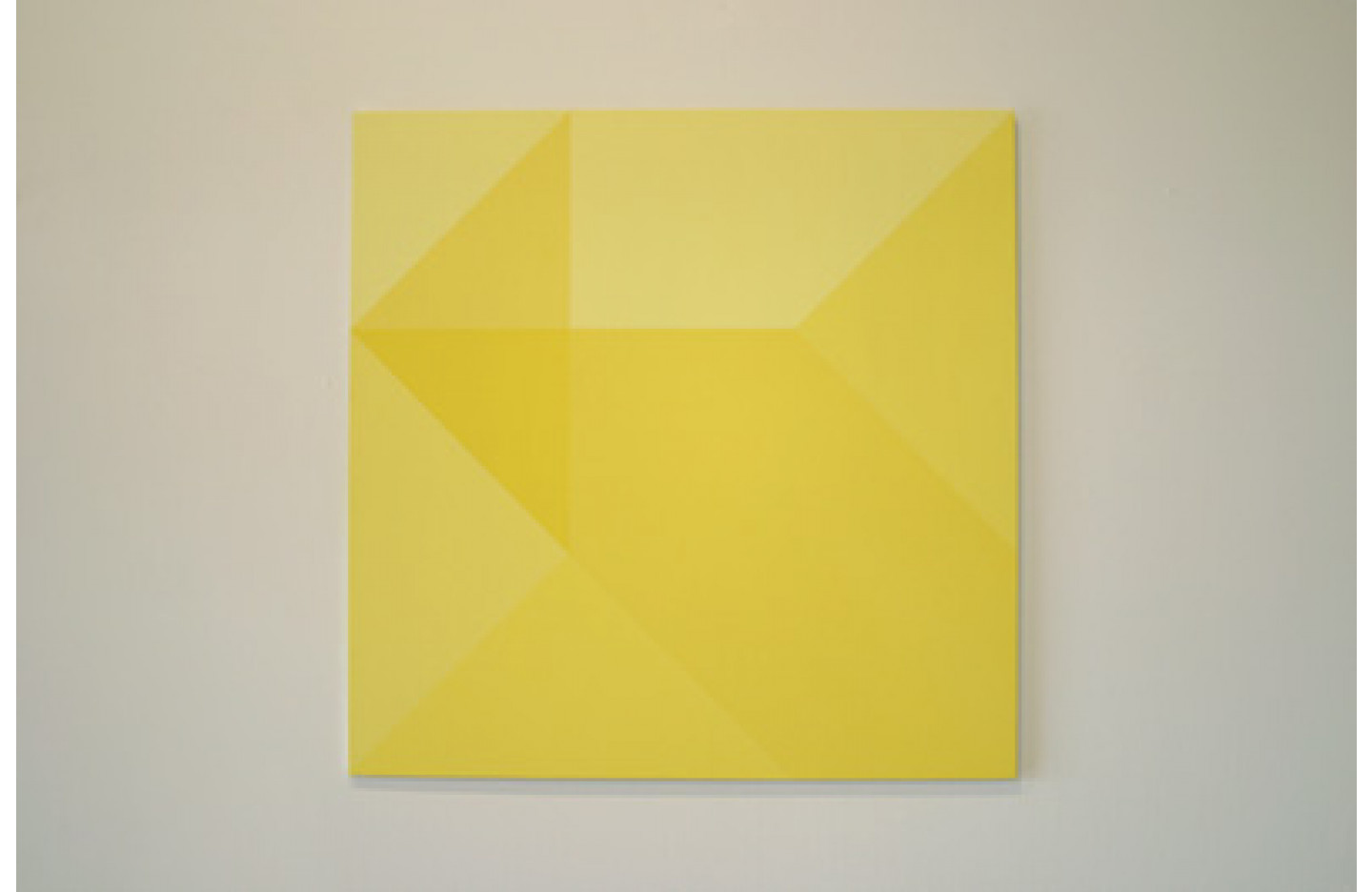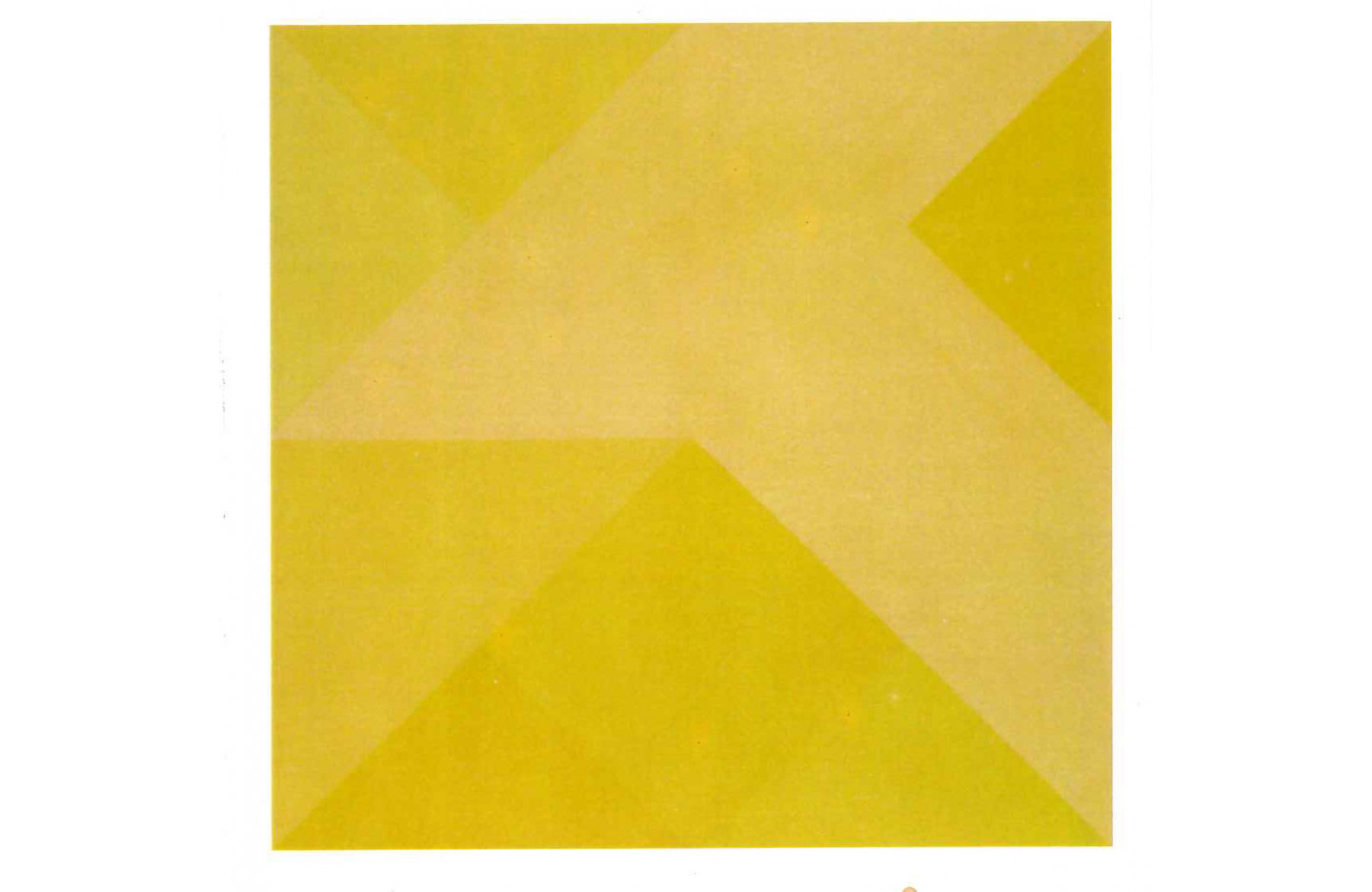Plane
- 18 Feb - 7 Mar, 2003
Jeena Shin's painting process has been refined over a number of years. She begins by constructing a folded model, which she defines as her 'working drawing'. If we take one step outside the discipline of painting and acknowledge the architectonic nuances present in her work, to assign the model the status of a working drawing, or, more accurately, a preparatory drawing/sketch,1 toward the final outcome, seems rather perplexing. In conventional architectural practice drawings are used as an initial means of investigation during sketch design. These drawings are often used to construct a scale model that is responsive to particular exigencies of site and context. In contrast, Shin, as an artist is unhindered by these mundane prescriptions, yet it seems they in some way inform her reversal of their order of appearance. The inversion of this working process from three dimensions to two is utilized, it will be argued, to perhaps question notions of another form of ground, one lodged in art historical traditions, namely the position of the viewing subject in relation to abstract painting. To begin with the model, the proximate outcome, and proceed to unravel it seems to suggest Shin may be compelled toward dwelling within the itinerant mechanisms of the model's, and, consequently painting's construction. As a result, Shin's work is perpetually tangled up within elegant spatial conundrums that defy conventional modes of categorization.
Shin folds a pristine square to create a collection of surfaces, both enveloping and developing. In a Deleuzian sense:
"Folding-Unfolding no longer simply means tension-release, contraction-dilation, but enveloping-developing, involution-evolution." 2
The folds accumulate to gather three dimensions from two. This drawing/model is then unfolded in stages and the tracery of creases left on the parchment is recorded on graph paper. Shin selects a number of these diagrams within the process to map out, sometimes in chronological order and at other times randomly chosen. Planes are indexed according to density, where areas subject to the most folding are darkest and areas in the process where the paper folds back in on itself remain void.
Shin paints with undercoat, a paint usually employed to act as a medium between primer and topcoat. Usually hidden, undercoat is situated as a constructional interim, lodged in a state of incompletion.
It is this quality of the interim that Shin's paintings seem to demonstrate. Like the undercoat, her constructional process negotiates a space between degrees of finish, yet in the final rendering she demonstrates an exquisite mantling of the painted surface. Generating lines are transferred to the painting surface and where planes intersect we can view the accretion of layering through pristine line work that recovers the scored edge of the initial model under construction. Shin mediates between stages of making in her production, an unraveling, and partial recuperation of the working drawing/model. Her paintings are pristine executions, exquisitely finished iterations of a perpetually folding and unfolding series of surfaces.
Whilst Shin unravels and remakes the drawing/object, documenting the mechanisms of its construction, the transfer of this information onto the painting surface is mediated by intuition. She will frequently elide different stages of the process within one work, or choose to paint the same diagram twice-in different tones and on different scales, as this exhibition illustrates. Her trenchant interrogation of interim conditions of making and their translation both into and onto the painted surface surrenders up another extensive dimension. The overlay of constructional seams of the process incites a third and potentially fourth, or, n dimension in the work. The space/time dimension examined by Cubist painters through the abolition of one point perspective was championed also by the De Stijl artist Theo Van Doesburg, who identified the fourth dimension as having a spatio-temporal quality mediated by architecture. This fourth dimension, Van Doesburg deigned the arena of the senses, of intuition, such that:
"Only abstract plasticity could present the abstract concepts of the fourth dimension, which springs entirely from human intuition" 3
Shin's work renders space illegible in conventional terms. Both orthographic and perspectival mechanisms have been abolished and replaced by a series of spatial conundrums where relationships between apparent foreground and background appear to oscillate and shift through the deployment of variable chromatic adjacencies and layering.
Art historian August Schmarsow, writing in the early 1900s, contested populist notions of form as stationary and space as void or absence. Instead, he argued for a conception of architecture contingent upon dynamic spatial perception, in which space was activated by the presence of a subjective viewer. This 'spatial intuition', is evidenced in Shin's work. Here, process and outcome also appear to sustain a relationship with the mathematical model of the Mobius strip: 4
"A perpetually transforming and regenerating configuration twisting space within space, converting volume to plane to point to volume, three dimensions to two to one, then back to space." 5
Many of Shin's works exhibit this enigmatic spatial paradox. Planes fold in on themselves in a state of perpetual (re)configuration. Her work presents an endless array of inward turning permutations.
She manufactures an unfixed space; the location of a ground line or datum in her works is consistently abolished. She employs the rules and logic of paper-folding, predicated on the symmetrical creasing of paper to produce a form, and then dismantles and reassesses its partial outcomes. She assembles and disassembles in order to study what lies beneath the finite surface of the form. Because she selects only partial stages in the development of the model/drawing moving backwards and forwards, her is not a linear process. It is instead a process and eventually outcome that speaks eloquently about temporal flux. The accretions of views that coalesce in her paintings seem to document a partial state in a perpetual trajectory of becoming. This movement is ascribed in elaborate dimensional shifts from three dimensions toward two to three to insinuate a fourth.
In discussions with the artist, Shin has expressed an interest in the way frontiers between interior and exterior are rendered negotiable. Beatriz Colomina has written about this obfuscation in relation to what we might consider immediately 'transparent' media, transposing them toward an analysis of the interior that reflects the subject viewing out from it:
"Photography and cinema seem, on first reflection, to be 'transparent' media. But that which is transparent, like the glass in our window also reflects (as becomes evident at night) the interior and superimposes it onto our vision of the exterior. The glass functions as a mirror when the camera obscura is lit." 6
Colomina localizes an instance of this reflection at work in Sigmund Freud's studio, where a mirror is situated on the same plane as the window, directly beside his work table, at the frontier separating inside from out. The mirror enables the projection of the self onto an outside world, and, as Colomina identifies:
"Freud's mirror, placed in the frontier that separates interior from exterior, undermines its status as a fixed limit. This is not without architectural consequences. The frontier is no longer a limit that separates, excludes, dissociates, a Cartesian limit; rather it is a figure, a convention, its aim is to permit a relation that has to be defined continuously. It is what Franco Rella would call a 'shadow line.' " 7
Shin's paintings demonstrate a similar interest in deactivating Cartesian limits, and offer up a simultaneity of viewer positions through their overlaid surfaces. When we view an object we can only ever approach it tangentially, gleaning a mere section or adumbration of its form, such that we are never privy to the full radiation of light omitted omni directionally from it. Norman Bryson, writing on a Japanese painting technique known as 'flung ink', invites a discussion of how one might recuperate these other views:
"What the image needs to include is the fact of the objects remainder, the other views which pass out from the objects to all those unaccountable places where the viewer is not" 8
Many of Shin's paintings dwell in this intermediary space, recovering traces of the initial models multi-dimensionality concurrently.
The use of reflection as a metaphorical device is cleverly employed. In a number of recent works, selected surfaces are finished in matt varnish. In these instances, she establishes a liminal coating without gloss, silencing the reflective qualities of this sealant, typically assigned a cloying sheen. In her works, reflection is not about the recapitulation of the self (the Lacanian mirror stage in which the infant learns to distinguish the I from the return gaze of the other I/the reflection of me) but is now about a surface that absorbs light. We do not seek ourselves out in the work but rather it supplies us with the opportunity to reflect upon reflection. By both insinuating and simultaneously evacuating the subject, her work prompts us to linger within its folds.
Stages in the process are superimposed and indexed through the use of subtle chromatic variations between adjacent planes. For this exhibition, she situates pure yellow paintings alongside fictional grey, an admixture of polar opposites.9 Proximities between greys, whites and creams establish their own adumbral affinities toward one another, picking up tonal after-effects of neighbouring planes. In the yellow and cream paintings the surfaces are rendered from dark to light. These works act as the complement to the grey paintings, acknowledging that when we deal with shadow we must necessarily deal with its inverse, light. This yellow, sunny-side up, is also, according to Jung, the colour associated with intuition.10
Shin directs an encounter between chromatic truth (yellow) and fiction (grey). Her paintings investigate the intricacies of illumination and its penumbral accomplice to great effect. Her paintings dwell in the interim, exploring the spatial complexities of the fold, made, unmade and remade: a process of becoming in perpetuity.![]()
Rachel Carley, 2003.![]()
1. In architectural practice a working drawing is one that specifically documents the dimensions and details for the construction of a building.
2. G. Deleuze, The Fold: Leibniz and the Baroque (trans. Tom Conley), University of Minnesota Press, Minneapolis, 1993, p.6.
3. C. Van de Ven, Space in Architecture, Van Gorcum Assen, The Netherlands, 1980, p.205.
4. Instructions for making a mobius strip:
"Take an ordinary flat strip of paper. Give it a half-twist. Now Scotch-tape the two ends together to form a loop. Okay, ready? Take a red Magic Marker and colour in one side of the loop, and a green Magic Marker and colour in the other side. Whoops! That's right: The strip has only one 'side'-or do we mean 'one' side'. Easy to construct and hard to imagine."
From Koolhaas, Rem, & Mau, S, M, L, XL, Monacelli Press, New York, 1998, p.926-8.
5. D. Ngo, & A. Shamir Zion, Open House: Unbound Space and the Modern Dwelling, Thames & Hudson, London, 2002, p.126.
6. B. Colomina, Privacy and Publicity: Modern Architecture as Mass Media, MIT Press, Cambridge, Massachusetts, 1996, p.80.
7. Ibid., p.80.
8. N. Bryson, "The Gaze in the Expanded Field" in Vision and Visuality, ed. Hal Foster, DIA Art Foundation No.2, 1988, p.103.
9. Arturo Schwartz comments on grey: "being the first colour perceived by the new-born, is related both to our preconscious and to rebirth."
A. Schwartz, Peter Halley Utopia's Diagrams, Temea Celeste, Milan, 1998, p.52.
10. Arturo Schwartz comments:
"Jung, for instance, believed that a person's preference for certain colours corresponds to the psychic activity, or 'psychological functions', two rational: thinking and feeling, and two irrational: sensation and intuition. These are, in turn, associated respectively with blue, red, green, and yellow."
Ibid., p.47.




